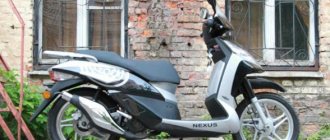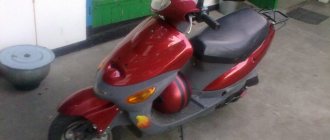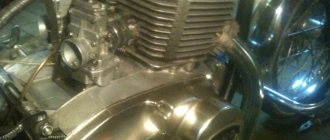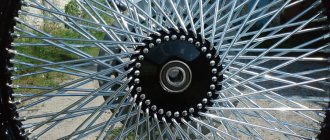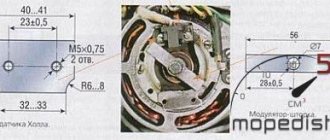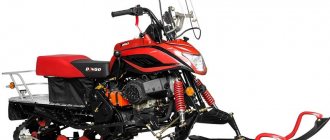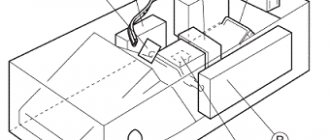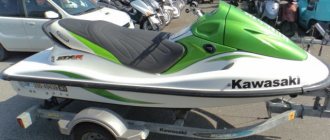Instructions for Vento Triton R4
Vento Triton R4 scooter operating instructions
- Study the rules carefully when driving.
- Fulfill the requirements set out by law (have a driver's license, plates, registration, etc.).
- Until you gain driving experience, we recommend using the Vento Triton scooter in areas with little traffic.
- Do not hand over the Vento Triton scooter to persons unfamiliar with its operation, as this may result in serious injury.
- Do not drive the Vento Triton scooter while drunk or under the influence of drugs.
- Follow traffic rules;
- Protective clothing must be worn;
- You should not be distracted while driving;
- Check the amount of oil and gasoline;
- The Vento Triton scooter is designed for two people;
Baggage
- Check the baggage securement carefully;
- Do not overload the Vento Triton scooter, luggage affects its stability and controllability;
- Luggage should be secured using slings or ropes;
- The maximum load should not exceed 10 kg;
Getting to know the scooter
1 - Right turn signal; 2 - Luggage compartment; 3 – Seat; 4 — Rear view mirror; 5 - Speed controller; 6 - Headlight; 7 - Exhaust pipe; 8 - Drum brake; 9 - Magneto; 10 — Pedal starter; 11 — Passenger step; 12 — Control panel 13 — Disc brake
Dashboard
| 1 — Speedometer: | Indicates speed in km/h; |
| 2 — Total mileage counter: | Indicates the distance traveled (total) in kilometers; |
| 3 — Left turn signal indicator: | Flashes when the left turn signal is on; |
| 4 — Right turn signal indicator: | Flashes when the right turn signal is on; |
| 5 — High beam indicator: | Lights up when the high beams are on; |
| 6 - Fuel indicator: | Shows the fuel level in the gas tank; Fuel level warning indicator (lights up when 1.0 liter of fuel remains in the gas tank). |
Main controls
Control panel located on the left handle (Fig. 6) 1. Horn switch - Press the switch to hear the horn; 2. Turn Signal Switch - To turn left, slide it to the left. To turn right, slide right. Must be pressed to turn off the turn signal; 3. Switching low/high beam - High beam - lever position up, low beam - lever position down. Control panel located on the right handle (Fig. 7) 1. Electric starter switch - Press and hold for no more than 5 seconds. The engine does not start, try after 30 seconds: 2. Lights - Move the switch to the left so that the headlight comes on. Move it even further, all the lights will light up.
Egnition lock
| WARNING: Do not use the key while the engine is running. 1. ON position Start the engine. When the ignition is on, do not remove the key. 2. OFF position The engine is turned off. Do not remove the key 3. LOCK position The lock is on. In this position the key can be removed. | Lock When leaving the scooter in the parking lot, set it to lock. 1. First turn the handle all the way. 2. Insert the key and turn it from the OFF position to the LOCK position. 3. Remove the key. |
| TIP: Try turning. handles to make sure the lock is set. | Unlocking Insert the key and turn it to the OFF position. |
Luggage compartment access
| Seat Lock 1. To open the lock, insert the key and turn it to the left. 2. Raise the seat and recline it. 3. Lower the seat and push it down, then you can lock the lock. TIP: Pull the seat up slightly to make sure it is closed. In rainy weather or when washing, water may enter the compartment, so do not store items here that could be damaged by contact with water. | Luggage compartment 1. Open the seat lock. 2. Raise the seat and you will find a compartment designed for 10 kg. You can store the manual and other documents for the scooter in the compartment. WARNING: Food spoils quickly when exposed to high temperatures and exhaust fumes, so do not store it under the seat. TIP: Do not store tools in the trunk when leaving the Vento Triton scooter unattended. |
| GAS TANK 1. In order to open the gas tank cap, you must insert the key and turn it to the right 2. The cap must be turned to the left and remove 3. Pour unleaded gasoline into the gas tank. 4. Put the cover in place, screw it on and lock the cover. Gas tank capacity: 6 l. |
WARNING: Gasoline is highly flammable and can catch fire under favorable conditions. When refueling, place the Vento Triton outdoors and in special places with good ventilation. Turn off the engine. Be careful not to get gasoline on your skin, and try not to inhale fuel vapors or swallow it.
Engine starting
| WARNING: Place the Vento Triton on the main stand and use the starter switch to start the engine. The driver must stand to the left of the Vento Triton scooter. Start the engine in an open area, as the gases are toxic. 1. Turn the switch to the on position. | 2. Press the rear brake lever. 3. While holding the handles, press the electric starter. 4. Try not to drive fast on a cold engine. |
Using the pedal starter
1. Set the main switch to ON position.
2. Place your foot on the starter lever and push it hard.
ADVICE:
After starting the engine, return the starter to its original position.
| Riding 1. Move the main support back, press the rear brake lever with your left hand, and with your right hand grab the handle and push the Vento Triton scooter forward. Advice: Do not grab the seat to remove the Vento Triton from the stand. 2. Sit on the seat. Grab the handles and sit on the left side of the scooter. Leave your left leg on the ground and throw your right leg over the seat. Sit more comfortably. 3. To ride together, you need to fold down the rear step. If the driver is alone, the step remains closed | Attention: To ensure that the engine starts easily, press the brake until it starts, then release it smoothly. During startup, do not allow the Vento Triton to accelerate suddenly. 4. Smoothly release the brake, turn the handles and the scooter will begin to move. Speed adjustment: Use the remote control to adjust the speed. 1. Turn towards yourself: the speed will increase. 2. Turn away from you: the speed will decrease. |
Braking system
| Attention: Slow down by turning the remote control away from you. Hold the rear and front brake handles and press them down and apply the brakes smoothly and continuously. If you decide to stop on an incline, use two brakes at the same time, do not rely on the speed control, this may lead to damage to the scooter. | On wet, snowy roads and when there is ice, you should brake in advance, at such times the braking distance increases. You should not brake several times on slopes; there is a possibility of damage to the Vento Triton . Don't forget to check your brake oil regularly. |
| Parking Try not to leave: 1) the Vento Triton leaning against the wall; 2) unattended; 3) the switch is in the ON position; 4) the key is not removed; 5) do not ride the Vento Triton scooter if it is standing on a support; 6) do not touch the hot mechanisms of the Vento Triton scooter. |
| Proper operation of the engine ensures its longevity. 0-100 km During the first 100 km, drive carefully and slowly, avoid sudden and prolonged braking. 0-500 km During the first 500 km, the speed should not exceed 80% of the maximum. After 1000 km Smoothly move to the highest speed. ATTENTION: Changing numbers is punishable by law. | Identification of the VentoTriton scooter We recommend that you write down information about the scooter below in case it is stolen. |
| Inspecting Your Scooter The more often you inspect your scooter, the longer it will last. Daily Checks Carry out checks every day. Regular checks Checking your Vento Triton scooter every 6 months will keep it in excellent technical condition. Warning: If you are careless with your Vento Triton scooter, you may face problems. If you have not used your Vento Triton scooter for a long time, we definitely recommend checking the technical condition of your “horse”. | We recommend checking more frequently if you have used your Vento Triton scooter in rainy weather. Daily check 1.Brake system: - Smooth operation and responsiveness to your inputs. 2. Tires: — Check for cracks and other damage; — Presence of abnormal wear; — Check the tread depth. 3. Engine: — The appearance of atypical noises; - Accelerates poorly. |
Brakes
| Checking disc brakes: Check the fastening of the brakes on the rear side; if they are worn out, replace them immediately. Filling the brake oil If you find a minimum amount of brake fluid, add DOT3 or DOT4. Attention: 1. It is not recommended to use oil of inferior quality; 2. Do not allow oil to come into contact with the painted parts of the Vento Triton , as the paint may crack or fade. ENGINE OIL Check the engine oil level: 1. Place the scooter on a flat surface; 2. Unscrew the cap, check the oil level; 3. Add oil of a certain brand to the level; 4. Remember to check the oil level regularly. | To check whether the resistance is maintained, press the rear brake handle. Measure whether there is still travel within the stated range. To adjust the stroke, turn the nut to the right to increase or to the left to decrease. Attention: The nut must be kept in perfect condition. Tip: You should check the stroke of the lever after making the adjustment. Check that the indicator line is within the required limits by pressing the brake lever. Attention: - Do not use low-quality oil, this may lead to engine damage; — Place the Vento Triton scooter on a flat surface (on an uneven surface the result will be incorrect); — Change the oil regularly. |
Changing the engine oil
- Don't forget to remove the drain screw from the plug.
- For ease of draining the oil, we recommend draining it when the engine is warm.
- Fill the gearbox with new oil.
- Reinstall the drain screw.
- Install the plug and tighten it properly.
- Use brand oil: 10W - 40.
AIR FILTER
| The air filter should be cleaned every 1000 km (621 miles) and depending on operating conditions. If you use your scooter in rainy weather, you should wash it more often. | Attention: If the filter is worn out, replace it. If the filter was not installed and secured correctly, dust could enter the engine, causing rapid wear and serious damage. |
| Cleaning: 1. Place the Vento Triton on a support; 2. After unscrewing the two fixing bolts and the clamp, remove the filter. 3. Unscrew the screw on the top of the filter and remove the cover. 4. After removing the filter, wash it with solvent 5. Reinstall the filter and secure it. | When washing the scooter, try not to get the filter wet, otherwise the engine may not start. |
Battery
| The battery is located under the driver's feet. Battery model 12v-7AH. Check the electrolyte level in the battery every 1000 km. Attention: - Try not to splash the electrolyte; — Do not open the sealed battery container. | Check: 1. The starter must be in the OFF position. 2. Open the battery cover. 3. Add electrolyte. The exception is a sealed container that does not require maintenance. |
Washing the scooter
| Tip: 1. Remove dirt with a soft cloth under running water. 2. Use neutral products and remove stuck dirt under running water. 3. Remove any remaining moisture with a clean, soft cloth. | Wax is used on painted and plastic parts of the scooter to prevent scratches. |
| Attention: * The scooter can be washed when the engine has cooled down. * To avoid premature rusting and short circuits, keep water away from the exhaust pipe, filter and electrical components. | * Drive the Vento Triton scooter with care after washing as it may affect the brakes. You should wait until the Vento Triton scooter is completely dry before riding. |
| Storage Before preparing for long-term storage, cover the exhaust pipe and the engine to prevent dust from entering. During long-term storage: 1. To avoid rusting, coat all components with wax; 2. To preserve the battery and prevent electrolyte leakage, it is necessary to install it in a well-ventilated room. Otherwise, disconnect the negative pole; 3.Remove gasoline from the carburetor. | Attention: After storage
Note: After long-term storage, try the Vento Triton at medium speed. |
Technical characteristics of Vento Triton R4
| ENGINE | |
| engine's type | 4-stroke, 1 cylinder, air cooled |
| Engine displacement | 47.9 cm? |
| Maximum power | 2.72 hp (2.0 kW) |
| Maximum speed | 70 km/h |
| Maximum load | 75 kg |
| Starting system | Electric starter and kick starter |
| Fuel tank capacity | 6 l. |
| Battery | 12v7AH |
| CHASSIS | |
| Front brake | Disk |
| Rear brake | Drum |
| Wheel diameter front/rear | 3.50-10-4PR/ 3.50-10-4PR |
| Fuel consumption (l/100 km) | 3.5 l. |
| Discs | Aluminum |
| MAIN PARAMETERS | |
| Length | 1820 mm |
| Width | 690 mm |
| Height | 1095 mm |
| Dry weight | 92 kg |
| Number of places | 2 |
| Analogue panel, alarm, remote start, underseat storage | |
“KETAICHEG.” Chinese Vento scooters.
Vitaly SERGEEV, photo by Dmitry TYURIN
(Page 1) [1]
[2]
VENTO Triton 4R
, scooter Year of manufacture 2006, Engine 50 cm3, Max. power 4.9 hp, Max. speed 80 km/h, Weight 94 kg, Approximate price 45,000 rub.
VENTO Triton 4R
, scooter, tuned. Engine 70 cm3, Max. power 12 hp, Max. speed 105 km/h, Approximate price 70,000 rub.
Chinese-made scooters for the most part do not amaze with stunning dynamics; they are low-speed “holes”, and you can’t expect more from them. However, there is also a minority... The owner calls one of them “KETAICHEG”.
What kind of miracle is this? It turned out to be Vento Triton. Yeah, the device is a little over-the-top. Below is a list of changes made. The owner came to the test with a friend, both on Tritons; the second is stock. Great, let's compare.
I got behind the wheel of a standard... And that's all you can do? “Gas to the floor” - the scooter went slowly. I understand that this is only a “fifty dollar”, but some Yamaha Jog starts with much greater prowess. So what if I compare it with the “Japanese”! Does a “Chinese scooter” imply the agility of an old gelding?.. And if I put a passenger behind me, the acceleration completely “failed”. In a word, it's boring.
But the other scooter was a bit of fun. This is understandable: the engine has been completely rebuilt. The cylinder-piston group is Airsal t-6, it increased the cylinder volume to 70 cm3. In accordance with the increased cubic capacity, the owner installed (properly!) a reinforced MHR RHQ crankshaft. In the power system, the standard carb was replaced with a tuning one with a diffuser diameter of 19.5 mm. Next: low resistance filter S6, reed valve - with manifold S6. Once you have implemented a more advanced intake system, take care of the exhaust as well. To make the motor ventilate better, I replaced it with Technigas RS forward flow. And the key point of modernization was the modification of the crankcase. After the “witchcraft” the engine began to produce 12 hp! It’s clear that the stock transmission cannot cope with the increased loads, so the owner replaced it with an MHR.
What did you get? Fast acceleration, maximum speed (according to GPS readings) was 105 km/h! A warm engine can pull the nose out of the spark plug. The engine spins up very quickly - you can hear it in the changing timbre of the exhaust. Here is a striking example of how replacing the power plant transformed a poor “stool” into an equal participant in traffic on city avenues. A very important side effect of modernization is that the level of pilot safety has increased. While driving such a vehicle, you will be able to quickly “evaporate” from the emergency zone, withstand the turbulence caused by a passing road train, and in a host of other unsafe road situations. The most valuable victory is that with the tuning of the engine and its “peripherals” done, you won’t have to “vomit” in the right lane.
Simple and convenient. Carbon is not real - it's an imitation. With the thumb of your right hand wrapped around the handle, you can easily reach the electric start button.
How does the chassis behave? That's what it is - a running car. At the front there is a telescopic fork of the usual type (I can’t even imagine a lever fork on a scooter with a sporty design!), and at the rear there is a good monoshock absorber. The suspensions, as they are supposed to, handle road unevenness - their energy intensity is enough for a “stuffed” scooter, and for a standard one it’s too much for the eyes. The same cannot be said about the frame. Its rigidity is sufficient for a “slow-moving” vehicle - you are not drawn to daring piloting in it. But not for the “projectile”! In deep rolls when cornering, it begins to “break”, “play” on bumps and thereby knocks your composure out of you. Try to evaluate the degree of adhesion of the rear tire to the asphalt if the “stern” “walks” from side to side... The looseness of the device was cured by the owner: between the frame pipes coming from the steering wheel, spacers were welded under the floor. It helped - the “frame” became stiffer, the sausage stopped coming apart. You might say that the mass has increased. Yes. So what? Unlike motorcycles, in which they try to keep weight to a minimum, for fifty-kopeck scooters, excessive thinness is not always good.
(Page 1) [1] [2]
